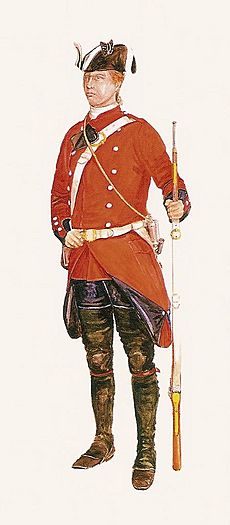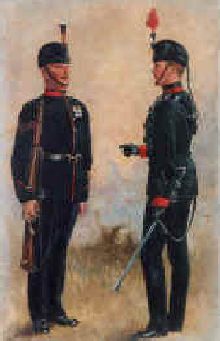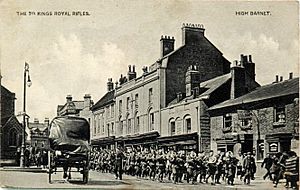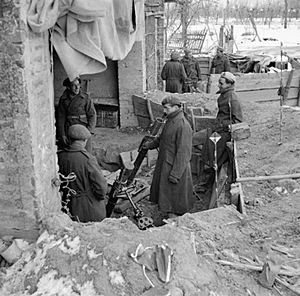King's Royal Rifle Corps facts for kids
Quick facts for kids 62nd (Royal American) Regiment60th (Royal American) Regiment Duke of York's Own Rifle Corps King's Royal Rifle Corps |
|
|---|---|
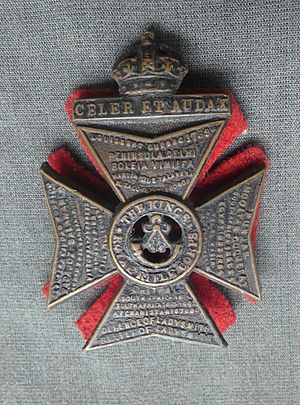
Cap badge of the King's Royal Rifle Corps
|
|
| Active | 1756–1966 |
| Country | |
| Branch | |
| Type | Rifles |
| Role | Light infantry |
| Size | 4 Battalions in peacetime (28 during the Great War) |
| Garrison/HQ | Peninsula Barracks, Winchester |
| Nickname(s) | 60th Rifles Royal Americans The Jaggers |
| Motto(s) | Celer et Audax (Swift and Bold) |
| March | Lützow's Wild Chase |
| Anniversaries | Christmas Day (Formation) |
| Engagements | French and Indian War American Revolutionary War Napoleonic Wars Anglo-Egyptian War Second Boer War First World War Second World War |
The King's Royal Rifle Corps (KRRC) was a special British Army infantry unit. It was first formed in North America in 1756. Back then, it was called the Royal American Regiment. This was during a big war called the Seven Years' War, also known as the French and Indian War in America.
The regiment, later known as the 60th Regiment of Foot, served for over 200 years. They fought all over the British Empire. In 1958, the KRRC joined two other regiments to form the Green Jackets Brigade. Then, in 1966, these three regiments officially combined to become the Royal Green Jackets. The KRRC became the 2nd Battalion of this new group. Later, it became the 1st Battalion, Royal Green Jackets. In 2007, it changed again to become the 2nd Battalion, The Rifles.
Contents
History of the King's Royal Rifle Corps
Fighting in the French and Indian War
The King's Royal Rifle Corps started in the American colonies in 1756. It was called the 62nd (Royal American) Regiment. Its job was to protect the colonies from attacks by the French and their Native American allies. After a big defeat for the British in 1755, the King and Parliament decided to create this new regiment. They even gave money for it just before Christmas 1755. That's why Christmas Day is seen as the regiment's birthday!
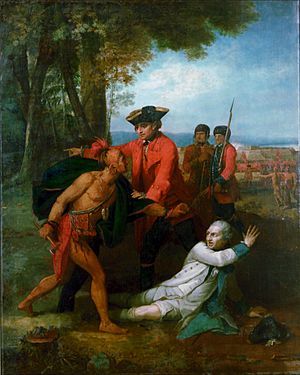
Parliament passed a special law in March 1756. This law created four groups, called battalions, each with 1,000 soldiers. These soldiers could even include people from other countries, which was unusual for the British Army. The Earl of Loudoun, who was the main commander in North America, became the regiment's leader. About 50 officers were from Germany and Switzerland.
The idea for this special force came from Jacques Prevost, a Swiss soldier. He knew that regular British soldiers weren't ready for fighting in forests. So, the regiment was designed to be good at forest warfare. They recruited Swiss and German forest fighting experts. They also took American colonists and British volunteers. These soldiers were Protestants, which was important because they were fighting against the mostly Catholic French. The officers came from all over Europe, not just America. This was the first time foreign officers were officially part of the British Army.
The regiment was renamed the 60th (Royal American) Regiment in February 1757. This happened after two other regiments were removed from the army list.
One important foreign officer was Henry Bouquet from Switzerland. He had new ideas about how soldiers should fight, train, and be managed. He even unofficially brought in rifles and more practical clothes for fighting in the woods. Many of his ideas later became common in the British Army.
Parts of the new regiment fought in several important battles. These included Louisbourg (1758), Quebec (1759), and the Montreal Campaign (1760). This last campaign helped Britain take control of Canada from France. At Quebec, General James Wolfe supposedly gave the 60th its famous motto: Celer et Audax, which means "Swift and Bold" in Latin.
After these big wars, the regiment faced a different kind of fight. This was during Pontiac's War in 1763. This frontier war threatened British control of North America. The regiment lost some small forts at first. But then, a group led by Henry Bouquet won a key victory at Bushy Run in August 1763.
The 60th wore red coats and traditional hats, like other British regiments. But for fighting in the woods, they swapped swords for hatchets. They also cut down their coats and hats to move more easily.
American War of Independence
Two more battalions (groups of soldiers) were created in England in 1775. These were mostly made up of men from England and Hanover. They were sent to Florida in 1776 to fight in the American War of Independence. They joined other parts of the regiment there.
These battalions fought in Georgia. They were involved in battles like Battle of Briar Creek in March 1779 and the Siege of Savannah in October 1779. During the Siege of Savannah, soldiers from the 4th Battalion captured a flag from an American regiment. These two battalions were later disbanded in 1783.
Napoleonic Wars
During the Napoleonic Wars, the regiment fought in the Peninsular War. The first four battalions were regular army units. But in 1797, a 5th battalion was formed in Barbados. This new group was fully equipped with rifles. These riflemen were so good that Sir Arthur Wellesley, a famous general, praised them. He called them "the most useful, active and brave troops in the field."
A 7th battalion was also created specifically to fight in the American War of 1812.
Later Wars and Changes
After the Napoleonic Wars, the regiment changed its name. First, in 1815, it became The Duke of York's Own Rifle Corps. Then, in 1830, it was named the King's Royal Rifle Corps (KRRC). In 1858, their main base was set up at Peninsula Barracks in Winchester.
The regiment fought in the Anglo-Egyptian War in 1882. Throughout the late 1800s, they also served in China, Canada, Afghanistan, India, Burma, and South Africa. They played a key role in the first battle of the Second Boer War at Talana Hill. Two officers from the regiment received the Victoria Cross, which is a very brave award. Another soldier, Private Frederick Corbett, also received the Victoria Cross. However, his award was later taken back.
In 1908, the army reorganized its volunteer and militia forces. The regiment then had two Reserve battalions but no Territorial battalions.
First World War
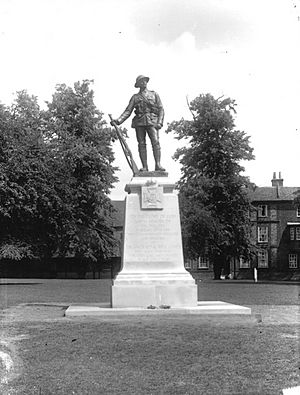
The KRRC had many battalions fighting in the First World War.
Regular Army Battalions
The 1st Battalion arrived in France in August 1914. They fought on the Western Front in many major battles. These included the Battle of Mons (1914), the First Battle of the Marne (1914), and the First Battle of Ypres (1914). They also fought at the Battle of the Somme (1916) and the Battle of Cambrai (1917).
The 2nd Battalion also landed in France in August 1914. They fought on the Western Front, including the Battle of Aubers Ridge (1915).
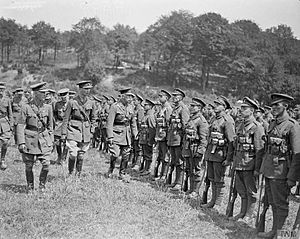
The 3rd and 4th Battalions arrived in France in December 1914. They both saw action at the Second Battle of Ypres in April 1915. The 4th Battalion later moved to Salonika before returning to France.
New Army Battalions
Many new battalions were formed for the war. The 7th, 8th, and 9th (Service) Battalions arrived in France in 1914 and 1915. They fought in battles like the Second Battle of Ypres (1915) and the Battle of Delville Wood (1916). They also took part in the Battle of Arras (1917) and the Battle of Passchendaele (1917).
The 10th, 11th, and 12th (Service) Battalions arrived in France in July 1915. They fought in battles like the Battle of Mont Sorrel (1916) and the Battle of the Somme battles. They also fought at the Battle of Cambrai (1917).
The 13th (Service) Battalion arrived in France in July 1915. They fought in the Battle of Morval (1916) and the Battle of Arras (1917). They also took part in the Battle of Passchendaele (1917) and the Hundred Days Offensive (1918).
Other service battalions included the 16th (Church Lads Brigade), 17th (British Empire League), 18th (Arts & Crafts), 20th (British Empire League Pioneers), and 21st (Yeoman Rifles). These battalions also served on the Western Front. The 21st Battalion even moved to Italy for a time.
Seven members of the regiment were awarded the Victoria Cross during the First World War.
Between the World Wars
After 1918, the KRRC served in places like India, Palestine, and Ireland. In 1922, the regiment was made smaller, going from four battalions to two. In 1926, it became one of the first mechanized infantry regiments. This meant they used vehicles instead of marching everywhere.
Second World War
The 1st Battalion, KRRC, went to North Africa when the war started. They fought in the Western Desert Campaign, including the Battle of Sidi Rezegh (1941) and the First Battle of El Alamein (1942). They also fought in the Second Battle of El Alamein (1942), a very important battle. A soldier named John Beeley was awarded a Victoria Cross after he died for his brave actions in North Africa. The battalion then fought in the Tunisian Campaign and later in the Italian Campaign.
The 2nd Battalion, KRRC, was part of the British Expeditionary Force (BEF) in France in May 1940. This battalion was lost defending Calais. Their brave stand helped slow down the German advance, which allowed many other British soldiers to escape at Dunkirk. The battalion was later reformed. It took part in the Battle of Gazala (1942) and the Second Battle of El Alamein (1942) in North Africa. Later, they were part of the Normandy landings in June 1944 and the fighting across North-West Europe.
Some Territorial Army (TA) units, like the Queen Victoria's Rifles, were also linked to the KRRC. The 1st Battalion of Queen Victoria's Rifles was also lost defending Calais in 1940. It was later reformed.
The 9th Battalion (The Rangers) went to the Mediterranean. They fought in the Greek campaign in April 1941 before being disbanded.
Royal Green Jackets and The Rifles
In 1958, the KRRC joined two other regiments to form the Green Jackets Brigade. The KRRC was renamed the 2nd Green Jackets, the King's Royal Rifle Corps. In 1966, these three regiments officially combined to form the Royal Green Jackets. The KRRC became the 2nd Battalion of this new regiment.
Regimental Museum
You can learn more about the King's Royal Rifle Corps at the Royal Green Jackets (Rifles) Museum. It is located at Peninsula Barracks in Winchester.
Territorial Battalions
During the Second World War, some Territorial Army battalions officially became part of the KRRC:
- 1st Battalion Queen Victoria's Rifles – became 7th Battalion KRRC
- 2nd Battalion Queen Victoria's Rifles – became 8th Battalion KRRC
- 1st Battalion The Rangers – became 9th Battalion KRRC
- 2nd Battalion The Rangers – became 10th Battalion KRRC
- 1st Battalion The Queen's Westminsters – became 11th Battalion KRRC
- 2nd Battalion The Queen's Westminsters – became 12th Battalion KRRC
Cadet Battalions
The King's Royal Rifle Corps also had cadet battalions for young people. The 1st Cadet Battalion was started in 1890 by Reverend Freeman Wills. He wanted to teach young people about military life. This cadet unit grew quickly. In 1894, it officially became the 1st Cadet Battalion, King's Royal Rifle Corps.
At first, these cadet groups were funded privately. But when they joined the KRRC, they received more support. In 1900, during the Second Boer War, some older cadets even volunteered to serve in South Africa. About 100 cadets served there, and some sadly died. Because of their service, King Edward VII allowed the battalion to wear a special honor: "South Africa 1900–1902." This makes them the only cadet unit in the UK with such an honor. They can also wear a small 60th cap badge and call their cadets "riflemen."
The 2nd Cadet Battalion was formed in 1942 during the Second World War. It was first called the Queen Victoria's Rifles Cadet Corps. In 1945, it was renamed the 2nd Cadet Battalion, The King's Royal Rifle Corps. In 1951, the 1st and 2nd Cadet Battalions joined together.
Today, the KRRC 1st Cadet Battalion still exists. It is made up of several companies within the Army Cadet Force.
Alliances
The King's Royal Rifle Corps had special connections, called alliances, with other military units. These included:
 Canada – The Queen's Own Rifles of Canada (1956–1966)
Canada – The Queen's Own Rifles of Canada (1956–1966) Canada - The Victoria Rifles of Canada (Until 1965)
Canada - The Victoria Rifles of Canada (Until 1965) Canada - The Royal Rifles of Canada (Until 1965)
Canada - The Royal Rifles of Canada (Until 1965) Canada - The Dufferin Rifles of Canada (Until 1936)
Canada - The Dufferin Rifles of Canada (Until 1936) Canada - The Dufferin and Haldimand Rifles of Canada (1936-1946)
Canada - The Dufferin and Haldimand Rifles of Canada (1936-1946) Canada - 56th Field Regiment (Dufferin and Haldimand Rifles), RCA (1946-1966)
Canada - 56th Field Regiment (Dufferin and Haldimand Rifles), RCA (1946-1966) Canada - The Halifax Rifles (Until 1965)
Canada - The Halifax Rifles (Until 1965) Canada - The King's Own Rifles of Canada (Until 1946)
Canada - The King's Own Rifles of Canada (Until 1946) Canada - The Saskatchewan Dragoons (1946-1966)
Canada - The Saskatchewan Dragoons (1946-1966) Canada - The Regina Rifle Regiment (Until 1966)
Canada - The Regina Rifle Regiment (Until 1966) Australia – Sydney University Regiment
Australia – Sydney University Regiment
See also
- Category:Battle honours of the King's Royal Rifle Corps
- Category:King's Royal Rifle Corps officers
- Category:King's Royal Rifle Corps soldiers
- Rifle Brigade – a sister regiment with similar history and traditions


